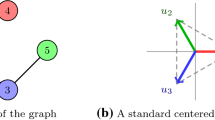Abstract
The Lovász theta number Lovász (IEEE Trans Inf Theory 25:1–7, 1979) is a well-known lower bound on the chromatic number of a graph \(G\), and \(\varPsi _K(G)\) is its impressive strengthening Gvozdenović and Laurent (SIAM J Optim 19(2):592–615, 2008). The bound \(\varPsi _K(G)\) was introduced in very specific and abstract setting which is tough to translate into usual mathematical programming framework. In the first part of this paper we unify the motivations and approaches to both bounds and rewrite them in a very similar settings which are easy to understand and straightforward to implement. In the second part of the paper we provide explanations how to solve efficiently the resulting semidefinite programs and how to use optimal solutions to get good coloring heuristics. We propose two vertex coloring heuristics based on \(\varPsi _K(G)\) and present numerical results on medium sized graphs.
Similar content being viewed by others
References
Arora S, Chlamtac E (2006) New approximation guarantee for chromatic number. In: Proceedings of the thirty-eighth annual ACM symposium on theory of computing, STOC ’06, pp 215–224. ACM, New York, NY, USA. doi:10.1145/1132516.1132548
Dukanovic I, Rendl F (2007) Semidefinite programming relaxations for graph coloring and maximal clique problems. Math Program 109:345–365
Dukanovic I, Rendl F (2008) A semidefinite programming-based heuristic for graph coloring. Discret Appl Math 156(2):180–189
Gvozdenović N, Laurent M (2008) Computing semidefinite programming lower bounds for the (fractional) chromatic number via block-diagonalization. SIAM J Optim 19(2):592–615. doi:10.1137/070683520
Gvozdenović N, Laurent M, Vallentin F (2009) Block-diagonal semidefinite programming hierarchies for 0/1 programming. Oper Res Lett 37(1):27–31. doi:10.1016/j.orl.2008.10.003
Karger D, Motwani R, Sudan M (1998) Approximate graph coloring by semidefinite programming. J Assoc Comput Mach 45:246–265
Lovász L (1979) On the shannon capacity of a graph. IEEE Trans Inf Theory 25:1–7
Malick J, Povh J, Rendl F, Wiegele A (2009) Regularization methods for semidefinite programming. SIAM J Optim 20(1):336–356. doi:10.1137/070704575
Povh J, Rendl F (2009) Copositive and semidefinite relaxations of the quadratic assignment problem. Discrete Optim 6(3):231–241. doi:10.1016/j.disopt.2009.01.002
Povh J, Rendl F, Wiegele A (2006) A boundary point method to solve semidefinite programs. Computing 78(3):277–286. doi:10.1007/s00607-006-0182-2
Acknowledgments
We thank to Igor Dukanovic for sharing his expertise and code for exact and approximate vertex coloring based on \(\varTheta \) function.
Author information
Authors and Affiliations
Corresponding author
Additional information
Supported by the Serbian Ministry of Education and Science (projects III 44006 and OI 174018), Supported by the Slovenian Research Agency (bilateral project no. BI-SR/10-11-040).
Rights and permissions
About this article
Cite this article
Govorčin, J., Gvozdenović, N. & Povh, J. New heuristics for the vertex coloring problem based on semidefinite programming. Cent Eur J Oper Res 21 (Suppl 1), 13–25 (2013). https://doi.org/10.1007/s10100-012-0276-1
Published:
Issue Date:
DOI: https://doi.org/10.1007/s10100-012-0276-1




